Santa Cruz Bronson 5
Wheel Size: 29’’ front / 27.5” rear
Travel: 150 mm rear / 160 mm front
Geometry Highlights:
- Sizes offered: S, M, L, XL, XXL
- Headtube angle: 64.2° (High) / 63.9° (Low)
- Reach: 480 mm (High) / 478 mm (Low) (size Large)
- Chainstay length: 442 mm (High) / 443 mm (Low) (size Large)
Frame Material: Carbon fiber (C and CC versions available)
Price:
- Complete bikes: $4,999 to $8,999
- Frame w/ Fox Float X Factory Shock: $3,899
Blister’s Measured Weight (Bronson XO Reserve, size L, w/o pedals): 32.4 lbs / 14.7 kg
Test Location: Washington, British Columbia, Colorado, & New Mexico
Reviewers:
- Simon Stewart: 6’, 170 lb / 183 cm, 74.8 kg
- David Golay: 6’, 160 lb / 183 cm, 72.6 kg
Test Duration: 4 months
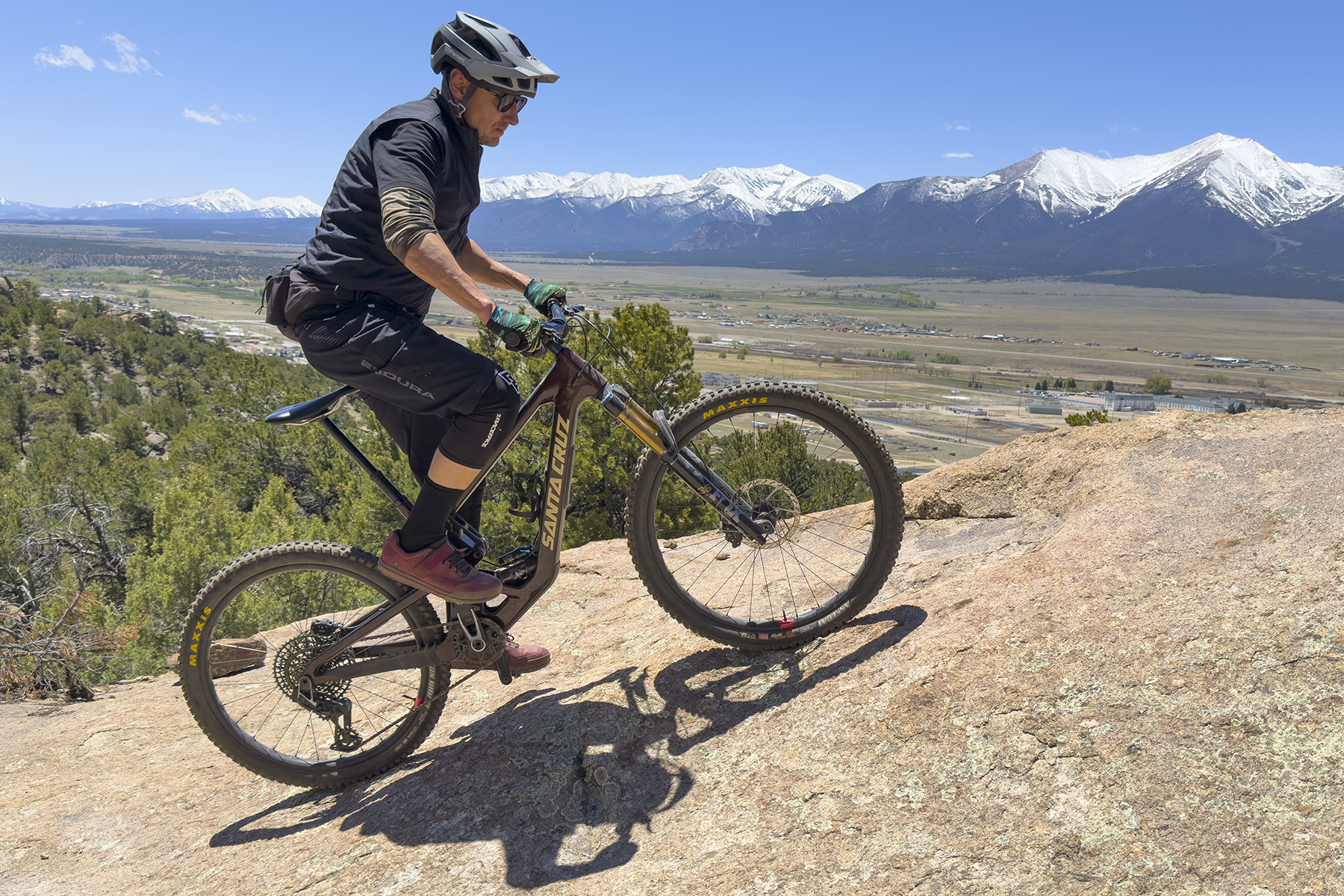
Intro
The prior-gen Bronson was Santa Cruz’s first mixed wheel bike apart from the V10 DH bike, and was well ahead of the curve in bringing the layout to a more all-rounder Trail bike, in a time (just a few years ago) where the layout was mostly reserved for big DH and Freeride bikes.
The new Bronson sees updates to improve the balance of the geometry as well as improving key parts of the suspension characteristics to reduce pedal kickback and create a smoother ride. The 150 mm travel Trail class is a bit of a Wild West category where bikes can end up with wildly different personalities, so let’s get into the details to see where Santa Cruz landed with the new Bronson.
The Frame
Santa Cruz’s familiar aesthetic continues with the new Bronson, built around the familiar low-slung VPP suspension layout that has been shared across most of the brand’s lineup for years now. The biggest aesthetic change is that the shock tunnel has a sizeable cutout just above and forward of the bottom bracket, but the overall layout and design language are still very identifiably Santa Cruz.
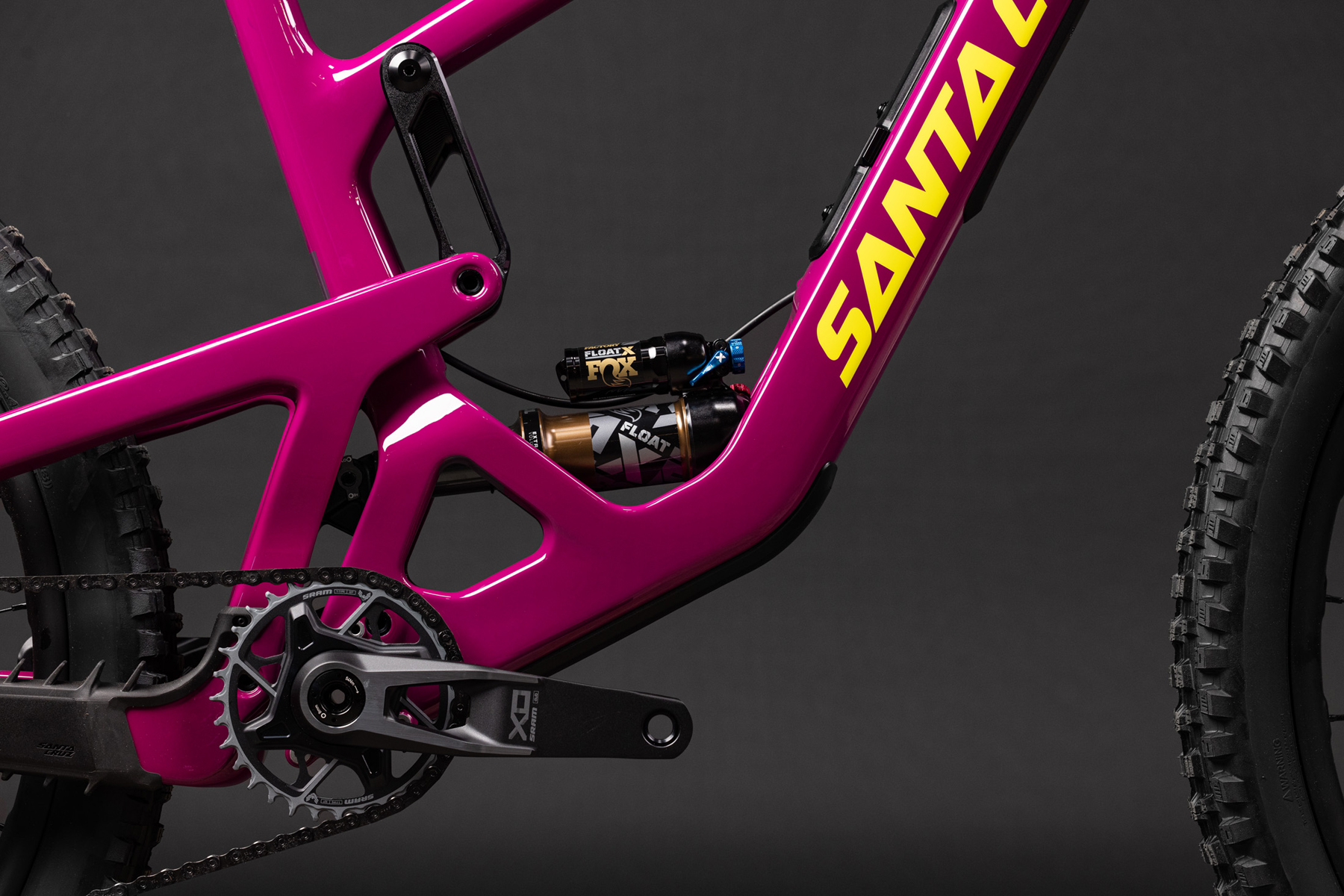
Mixed wheels are the only option on offer with the Bronson, and the 150 mm of rear travel and a 160 mm fork carry over, too. For now at least, the Bronson is a carbon-only affair, with the choice between the less expensive C grade carbon that adds a small bit of weight, or the top shelf CC grade frame.
Most of the other frame details are also what we’ve come to expect from Santa Cruz, including in-frame storage via the Glovebox system and internal cable routing. Interestingly, and perhaps frustratingly for the cable-actuated fans among us, the CC frames only offer internal routing for the dropper and rear brake — it’s wireless electronic shifting only on the high grade frame option. Fortunately the lower spec C models still include internal routing for a rear derailleur.
The rear suspension layout looks familiar, but has seen some rather substantial changes with the goal of reducing pedal kickback and creating more settled rear suspension performance. A closer look reveals a more forward lower pivot and new two-pillar shape around the shock tunnel, with the shock also moved farther forward in the frame to the point that it nestles into the downtube. It looks quite refined aesthetically, but more importantly it allows Santa Cruz to reduce anti-squat for a more active suspension under pedaling forces while also creating a smoother descending feel due to reduced pedal kickback.

Fit & Geometry
Santa Cruz is offering five sizes with the Bronson, ranging from Small to XXL. Unfortunately for particularly small folks, the XS size featuring dual 27.5’’ wheels has been retired. Each frame size now gets size-specific chainstays. A flip chip at the rear shock mount also allows for tweaking geometry between High and Low settings.
Across the board, the geometry has gotten a bit longer and taller relative to the outgoing version. Using a size Large frame as reference and in the High flip chip position, the Bronson features an 480 mm reach, relatively tall 641 mm stack, 64.2° headtube angle, and 442 mm chainstays. The effective seat tube angle is quite steep at 78.2°, and Santa Cruz projects a bottom bracket height of 344 mm.
Switching to the Low setting yields subtle changes. The reach shrinks slightly to 478 mm while the stack increases to 643 mm. The headtube angle drops to 63.9°, while the chainstays lengthen very slightly to 443 mm. The bottom bracket height drops to 341 mm, and the seat tube angle relaxes to 77.9°. If those sound like small changes, they are — while the flip chip adjustment is much less radical than with some other bikes, that could be a great thing for riders who are looking to slightly dial things in rather than make wholesale changes.
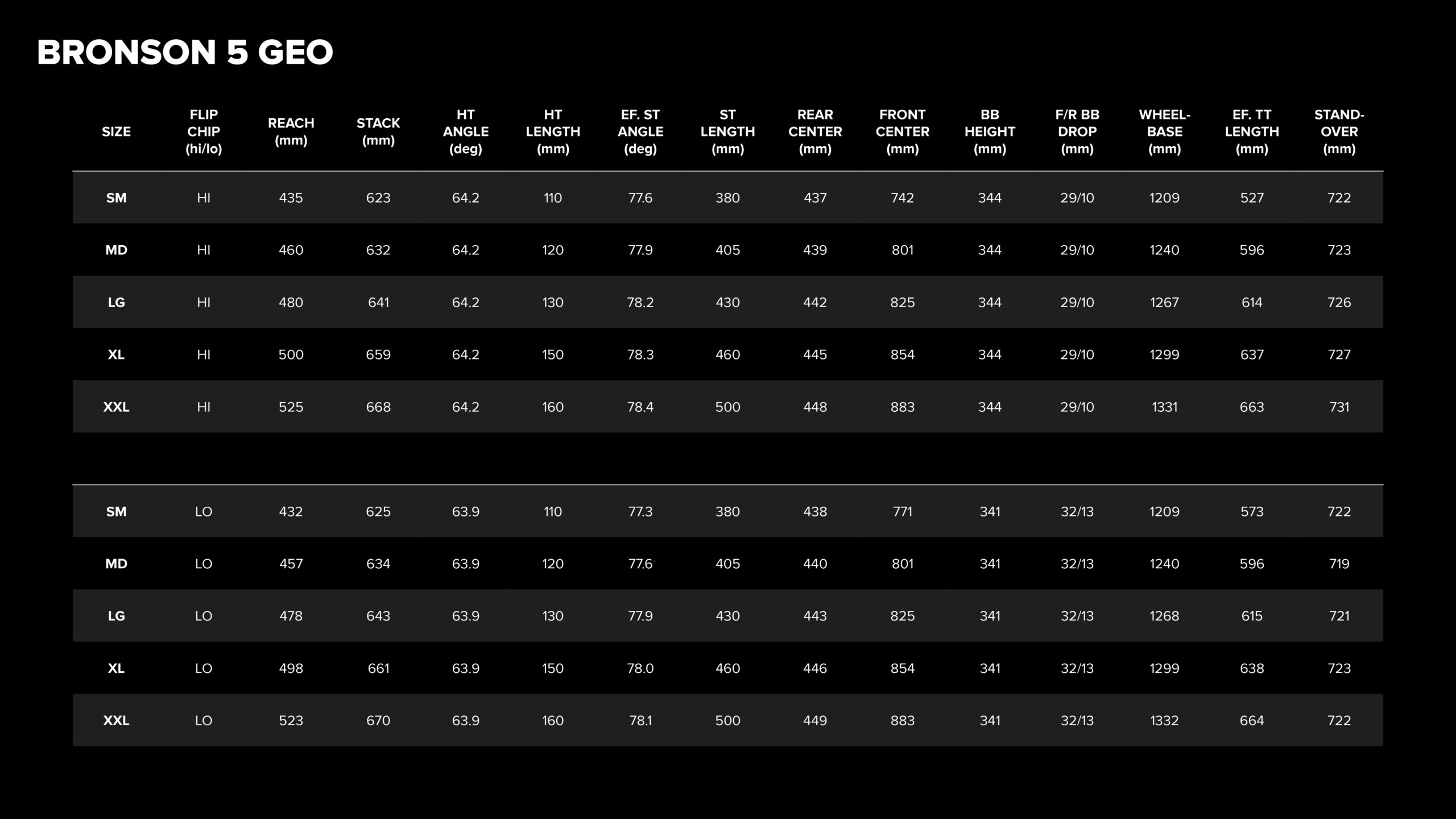
The Builds
Folks who are familiar with Santa Cruz’s build naming convention will find a familiar arrangement with the new Bronson. Ranging from the least expensive R build to the range-topping X0 AXS RSV, there are seven builds in total with the upper three all using electronic shifting from SRAM.

Aside from the RockShox Lyrik and Fox Rhythm shock on the R build, all other builds get some version of the Fox 36 fork and Fox Float X rear shock. Each bike gets 4-piston brakes too, with DB8 brakes on the R,S, and SRAM 70 builds while the burly Maven brakes handle stopping duties on the rest of the builds. Only the top two builds get the higher-spec CC carbon frames, with their lack of derailleur cable routing matched to SRAM Transmission shifting.
Full build specs are included as follows.
- Drivetrain: SRAM Eagle NX
- Brakes: SRAM DB8 (200 mm rotors)
- Fork: RockShox Lyrik Base (160 mm)
- Shock: Fox Float Performance
- Wheels: Reserve 30 TR 6061 rims / SRAM MTH hubs
- Dropper Post: SDG Tellis
- Drivetrain: SRAM 70 Eagle T-Type
- Brakes: SRAM DB8 (200 mm rotors)
- Fork: RockShox Lyrik Base (160 mm)
- Shock: Fox Float Rhythm
- Wheels: Reserve 30 TR 6061 rims / SRAM MTH hubs
- Dropper Post: SDG Tellis
- Drivetrain: SRAM Eagle GX
- Brakes: SRAM DB8 (200 mm rotors)
- Fork: Fox 36 Performance (160 mm)
- Shock: Fox Float X Performance
- Wheels: Reserve 30 TR 6061 rims / DT Swiss 370 hubs
- Dropper Post: OneUp V3
- Drivetrain: SRAM 90 Eagle T-Type
- Brakes: SRAM Maven Base (200 mm / 180 mm rotors)
Fork: Fox 36 - Performance (160 mm)
- Shock: Fox Float X Performance
- Wheels: Reserve 30 TR 6061 rims / DT Swiss 370 hubs
- Dropper Post: OneUp V3
- Drivetrain: SRAM Eagle GX
- Brakes: SRAM DB8 (200 mm rotors)
- Fork: Fox 36 Performance (160 mm)
- Shock: Fox Float X Performance
- Wheels: Reserve 30 TR 6061 rims / DT Swiss 370 hubs
- Dropper Post: OneUp V3
- Drivetrain: SRAM X0 Transmission
- Brakes: SRAM Maven Silver (200 mm front / 180 mm rear rotors)
- Fork: Fox 36 Factory (160 mm)
- Shock: Fox Float X Factory
- Wheels: Reserve 30 SL 6069 rims / Industry Nine 1/1 hubs
- Dropper Post: OneUp V3
- Drivetrain: SRAM X0 Transmission
- Brakes: SRAM Maven Silver (200 mm front / 180 mm rear rotors)
- Fork: Fox 36 Factory (160 mm)
- Shock: Fox Float X Factory
- Wheels: Reserve 30 HD carbon rims / Industry Nine 1/1 hubs
- Dropper Post: OneUp V3

Full Review
The prior-generation Santa Cruz Bronson 4 was an early pioneer in bringing mixed wheel sizes to a do-it-all Trail bike, and while the concept showed merit, it was also a bit rough around the edges.
Santa Cruz has stuck with the mixed wheel format for the latest Bronson 5, and while a lot of the geometry figures and kinematic details don’t look massively different, they’ve added up to produce a very different (and, spoiler alert, much more coherent) overall package.
So what is it that sets the Bronson 5 apart from its predecessor, and how does it slot into the extremely crowded 150 mm-travel Trail bike market? Here’s our take:
Fit & Sizing
Simon Stewart (6’, 170 lb / 183 cm, 74.8 kg): I had an easy time getting comfortable on the size Large Bronson, which is not surprising given my history of getting along very well with other Santa Cruz bikes in that size. Santa Cruz, in general, has been one of the more consistent brands with sizing across their various models, and you can expect very similar fit characteristics across the majority of their models for each respective size.
I would describe the Bronson as having a more compact fit than average for a size Large bike in today’s bike market, but I don’t find it to be cramped, and have ample room to move my body position around. I find the compact fit to be well-suited to the Bronson’s engaging character and playful intentions, which we’ll cover in much more detail below.
I’ll also get into how the fit relates to climbing performance in more detail in the “Climbing” section, but overall, Santa Cruz has done a nice job making the Bronson a comfortable place to spend time in a seated climbing position.
Contributing to the comfortable fit, Santa Cruz added some height to the stack (643 mm for size Large, Low setting) to the new Bronson. I’m a fan of higher stack heights, so that suits me quite well, which also means I could leave my Burgtec Ride High Josh Bryceland Signature bars on the parts shelf.
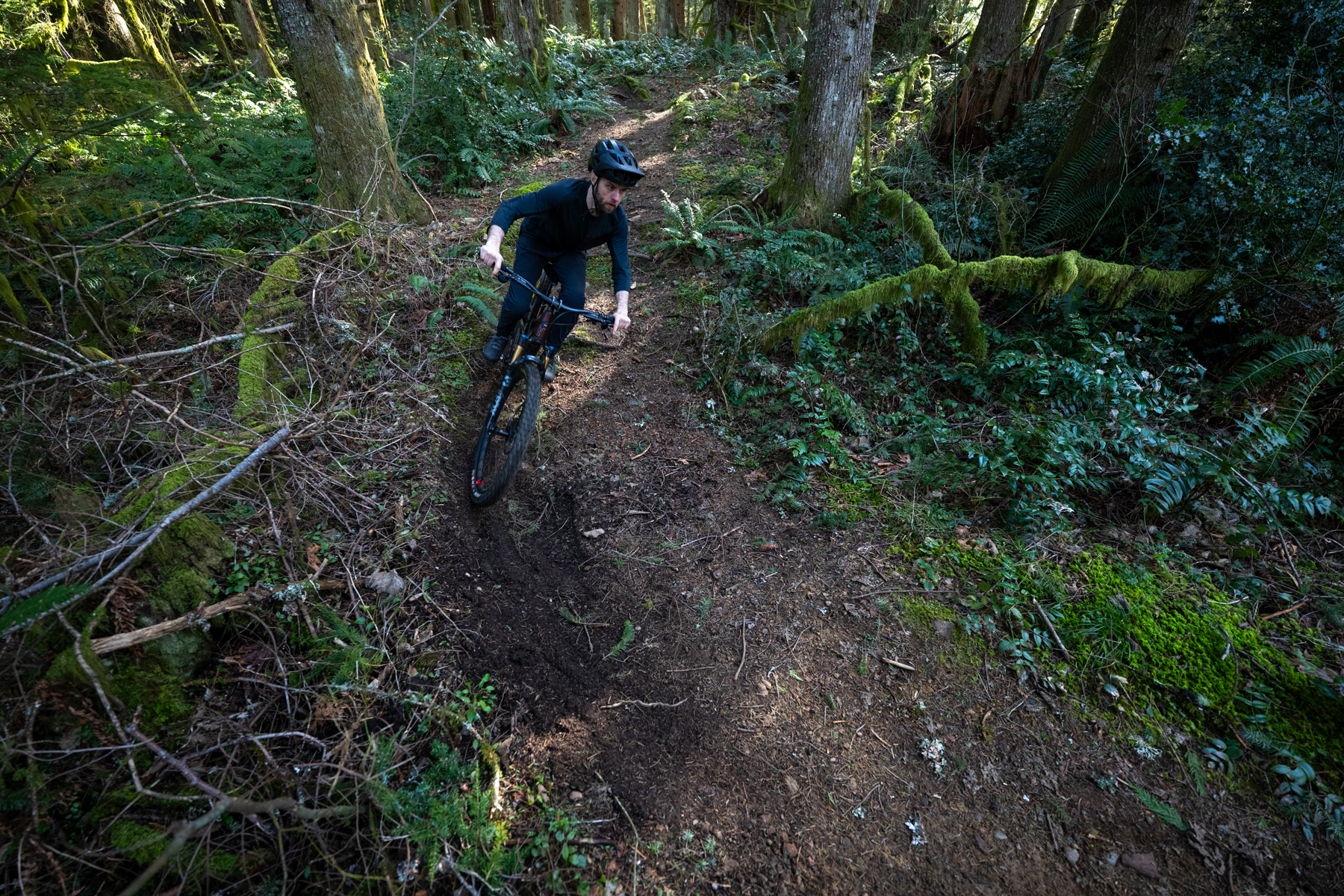
David Golay (6’, 160 lb / 183 cm, 72.6 kg): I also had an easy time getting comfortable on the Large Bronson, and don’t have a ton to add beyond what Simon already laid out. I’m in full agreement that the Large Bronson fits a little smaller than average for a modern size Large bike, but it’s in line with Santa Cruz’s sizing across most of their range.
I think I could also ride an XL Bronson reasonably comfortably if I wanted to size up and make it more stable, but, as we’ll get into below, I found the handling of the Large to be a nice fit for the overall personality of the Bronson. Santa Cruz’s recommended sizing bands put a 6’1’’ / 185 cm tall rider at the border between the Large and XL, so at 6’ / 183 cm, my take of “I could probably ride either but think the Large is the way to go for me” is more or less in line with their suggestions.
Given the Bronson’s slightly more compact fit, I made a few tweaks to the setup relative to what I’d do on some other, roomier bikes. Most notably, I ran the seat farther back on the rails to stretch the seated cockpit position out, and used a 10 mm wider bar than I often do (780 mm vs. my more typical 770 mm) to open the fit up a touch. With those tweaks made, I was happily up and running.
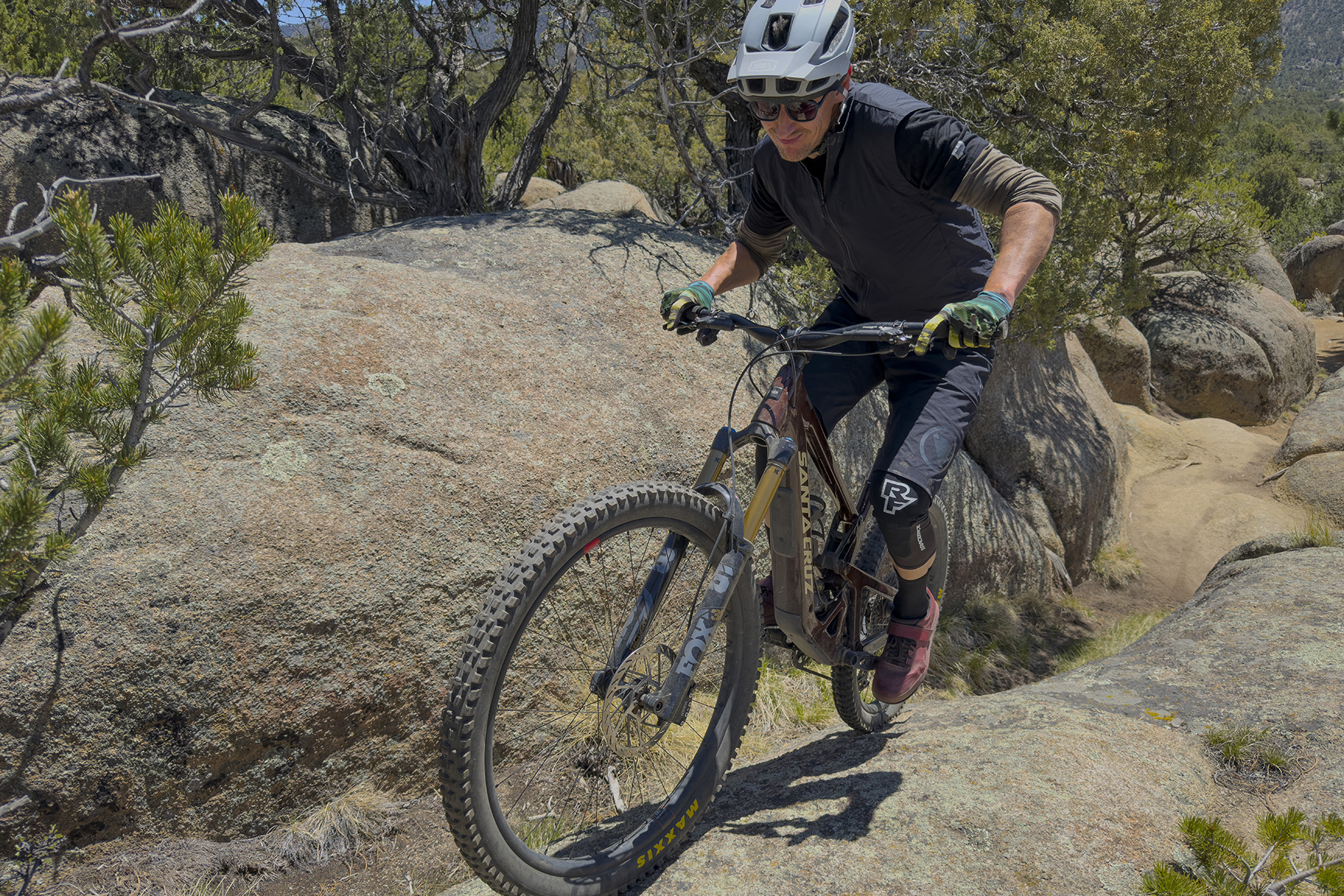
Climbing
Simon: When bikes are as playful as the Bronson (more on that in a minute), I usually don’t expect them to be particularly good technical climbers. That’s largely because bikes that are more planted and less playful typically offer better traction and more room to move around on the bike. Additionally, mixed-wheel size bikes often lose a bit of ease in getting the rear end over ledges and other substantial trail features, and they tend to get hung up more frequently.
But the Bronson surprised me on slow technical climbs, particularly its excellent traction. Santa Cruz claims to have dialed back anti-squat to create a more active suspension when pedaling, and while I haven’t spent time on the previous Bronson to compare it to (I’ll let David handle that), I’d say mission accomplished from my perspective.
The Bronson’s relatively compact fit, in combination with its high-ish bar height, helps the front end come up in an easily controlled manner; this contributes to the Bronson’s solid maneuverability in tight technical situations.
Other Santa Cruz bikes I’ve been on recently (and in the past) have felt quite stiff laterally, and the Bronson is no exception, which contributes to how well the Bronson handles substantial rider weight shifts. I sometimes throw my weight around significantly in technical sections, and the Bronson takes it intuitively, holding its line even in tricky off-camber areas. I wouldn’t go so far as to call the Bronson a category-leading technical climber, but it gets high marks for traction, maneuverability, and stability, so it ranks high on the list and instills confidence to go for the hard moves.
Another aspect of the Bronzon that stands out is its comfortable seated climbing position that makes long slogs (typical of my local Colorado trails) quite manageable. The Bronson isn’t the most responsive feeling in terms of pedalling efficiency, but it settles into a rhythm easily, and while it doesn’t necessarily encourage you to push your limits, it isn’t slow either.
More specifically, while the Bronson doesn’t feel particularly fast on climbs, it’s a little deceiving because, going by the clock, it’s not far behind other bikes in its class up a 3-mile, 1,400 ft double track ascent I often use to measure climbing performance. To be clear, I mostly use the climb to gauge efficiency and assess how the seated climbing position feels during a sustained effort. It’s far from a scientific measurement, but I try to keep most of the variables consistent and record how long it takes for reference. Not surprisingly, the far lighter and XC-oriented Yeti ASR shot up it like it had a motor and holds the fastest time (for a non-eMTB anyway). But to my point, the Spot Mayhem 140 feels notably quicker and more responsive than the Bronson 5, but the Mayhem 140 was only slightly faster.
Given the Bronson 5’s reduction in anti-squat, I was expecting its shock’s lock-out to be more necessary. However, toggling it doesn’t return an appreciable increase in efficiency, so after trying it once, I didn’t feel the need to use it again.
David: I’m in full agreement with Simon here. The Bronson 5 offers quite good traction under power, and while it doesn’t feel super snappy and responsive if you’re really trying to put the hammer down, it’s still reasonably efficient, provided that you keep your pedal stroke somewhat smooth-ish.
That’ll be a nice recipe for a lot of folks. The Bronson wouldn’t be my first recommendation if you specifically want an ultra-efficient ~150 mm-travel Trail bike that encourages you to put big power down a lot of the time (check out our Deep Dive on the Bronson for a lot more on that). But the little bit of efficiency it gives up compared to those sorts of bikes feels entirely in keeping with the Bronson’s relatively good traction and compliance under power. The Bronson’s efficiency still feels roughly middle-of-the-road for a 150 mm-travel bike — it is by no means notably inefficient — and, again, I think its balance of traits will work well for a lot of people.
As I touched on above, the effective top tube on the Large Bronson (614 mm) is a little on the short side for my typical preferences, but the seat tube angle is steep enough that I can happily move the seat back on the rails to buy myself a little more room without making the pedaling position feel awkward. Even with the seat shifted back farther than I’d run it on a lot of bikes, the Bronson doesn’t present any challenges keeping the front wheel planted, and its weight distribution feels pleasantly neutral.

Descending
Simon: I’ll start this section with cornering since I find it to be one of the Bronson 5’s standout attributes. David mentioned in his Flash Review how much he enjoyed cornering on the Bronson, and I’m in full agreement there. Many mixed-wheel-size bikes have a tendency to oversteer, leading to lots of tail-out antics, and the Bronson really hones in on that trait. Like David said, if you get the timing right to unweight the rear wheel, it comes around quickly and predictably. I also think it has a fairly big sweet spot for getting the timing right.
Additionally, the Bronson loves a lot of input from your feet to slide the back end around, which is incredibly rewarding and, to some extent, almost addictive. I found myself routinely seeking out corners to square off (usually left-handers, because, like skiing, I make better left-hand turns…), to the point where I had to remind myself that not every corner needs to be shralped.
David: The one thing I’ll add here is that, while the Bronson is an absolute blast if you want to slash the rear end around and square off corners, it doesn’t require you to do so, either. A lot of mixed-wheeled bikes (the prior-gen Bronson very much included), especially ones with short-ish chainstays, need you to stay forward on the bike to get good front-wheel grip, at which point the rear starts to feel pretty loose, whether or not you want it to. The Bronson 5 is very happy to get slashy if you choose to, but it’s also totally willing to let you ride it more neutrally, load it up through the pedals, and carve its way around corners (well-supported ones in particular).
Simon: Not surprisingly, given the Bronson’s penchant for getting loose in corners, it leans more in the playful, poppy direction rather than stable and planted. I clicked with it the most on flowier trails that have lots of opportunities to find creative lines. Backing up its playful personality, the Bronson feels great pumping through rollers while trying to keep the front wheel lofted in a manual, and then transitioning straight into hanging the rear wheel out in corners.
I found the Bronson to prefer a neutral riding position in most situations, but it is also not super sensitive to being ridden slightly more forward or rearward. David mentioned in his Flash Review that the Bronson 5 is considerably more balanced than the previous generation. I didn’t spend any time on the prior Bronson, but I have spent a good bit of time on the Santa Cruz Vala eMTB, which — at least in terms of wheel size, suspension travel, and geometry — is essentially a Bronson with a motor. Despite their different suspension layouts, I find them to have similarly good chassis balance and are pretty close in overall ride characteristics.
When things get rougher, it’s not that the Bronson runs out of talent, but it’s happier with a corresponding reduction in speed. Its suspension remains composed in most situations, but occasionally feels like it hardens up when hitting something just right; it doesn’t bottom out per se, but gets noticeably clunky.
This doesn’t happen very often, since it requires a decent amount of amplitude, and usually only occurs when I’ve lost a bit of concentration and thus am not riding smoothly. Since the Bronson likes to be ridden with an active and engaged riding style, it can be a convenient reminder to get it together and ride with more intention. David had a similar experience when pushing the Bronson hard into rooty sections, but like me, doesn’t find it to be a distracting issue.

David: I agree with quite a bit of what Simon wrote in that last section, but my thoughts differ in a few of the details. The Bronson’s suspension offers a slightly unusual (and in a lot of ways, quite compelling) combination of relatively good initial sensitivity and traction, while still being relatively poppy and lively overall. Especially on faster, rougher trails, the Bronson prefers to be ridden somewhat actively and dynamically rather than trying to just steamroll whatever’s in front of it. Still, I didn’t feel the need to back off the pace so much as I just needed to make a point of boosting off stuff and smoothing out certain sections by skipping over them, more so than I do on some other bikes in this general travel bracket.
The Bronson facilitates that sort of riding quite well. It also feels more energetic and engaging on smoother, flowier trails than most bikes that I’d rate as being a significant step up in plantedness and composure when you want to get smashy. But, as Simon mentioned, I found the Bronson’s suspension to have a surprising tendency to make a big clunk — both audible and felt through my feet — on certain sharp, medium-to-large impacts (such as running into a mess of roots at speed). It doesn’t happen every time, and comes up most often when the bike is already a bit unsettled before the square-edged hit, but can be quite harsh in its worst instances.
Running an OChain on the Bronson was extremely effective in tamping down the clunk that Simon and I both experienced. My hunch is that what I was feeling had more to do with chain movement and feedback related to that, rather than actually being “pedal kickback,” but in any case, it doesn’t sound or feel great. Adding an OChain took care of it.
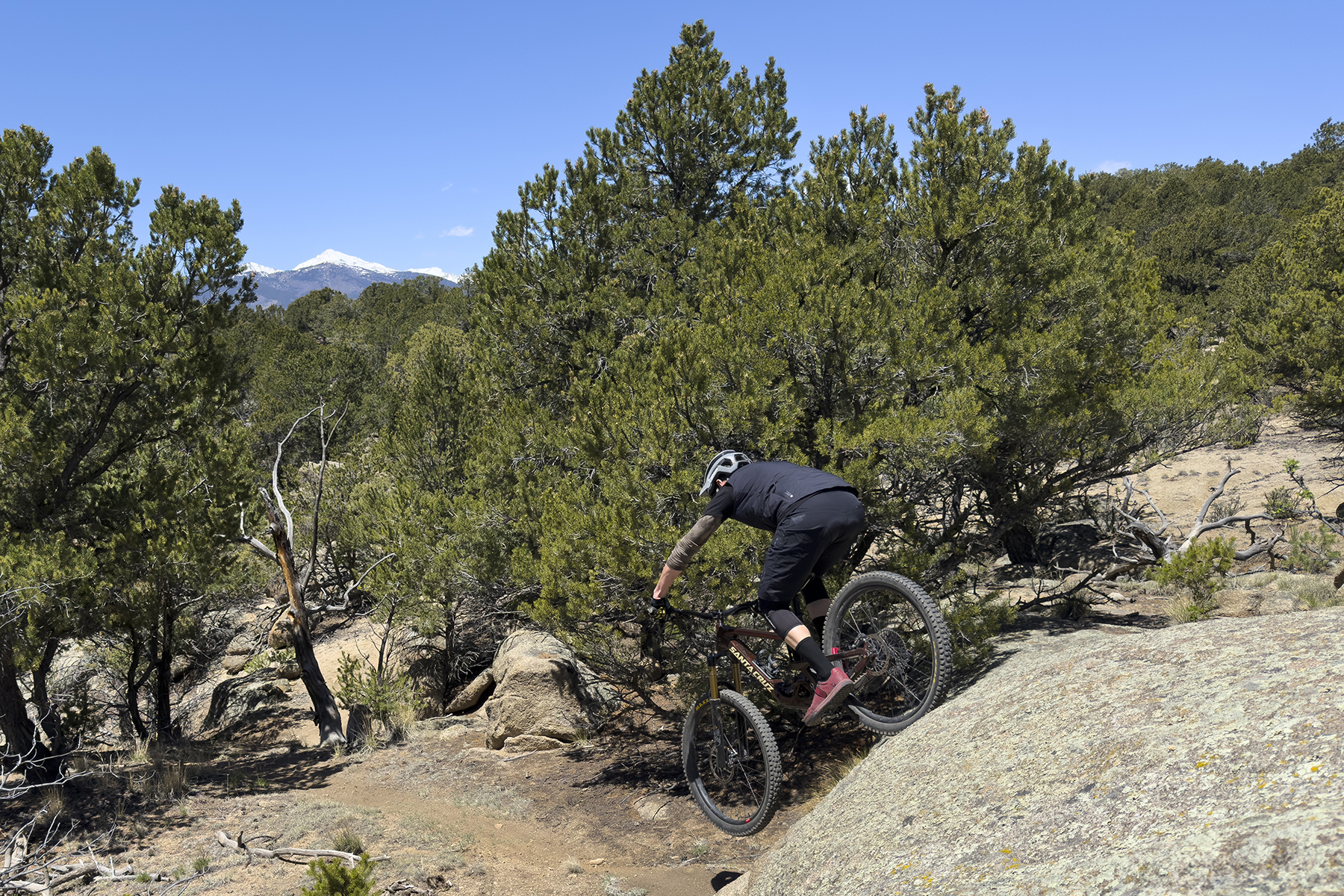
Simon: Rather than straight-lining through chunder, the Bronson 5 excels at mining the fun out of less exciting sections of trail, and really leans into its playfulness. I consider that to be a quintessential mixed-wheel-size Trail bike trait, and the Bronson does it better than a lot of other bikes in the category.
My preferred setting for the Bronson’s flip chip was the Low one. The flip chip’s effect on fit and handling is very subtle, and no single number stands out as feeling dramatically changed. However, the collective change of a slightly slacker head tube angle, higher stack, slacker seat tube angle, and lower bottom bracket gives it a slightly more aggressive feel overall, which is noticeable. I didn’t find an appreciable decrease in steep climbing performance due to the somewhat slacker effective seat tube angle, nor did I notice more crank strikes from the lower bottom bracket.
Overall, while I’m impressed by the Bronson’s climbing performance, I believe it’s a better descender, and I think that slight descending advantage aligns with what we expect from the Bronson.
David: I also prefer the Low flip chip setting overall. Simon’s right to note that the difference between the two settings is relatively subtle, but the low setting makes the Bronson a touch more stable and (more significantly in my book) enhances some of its cornering prowess that we already touched on. The High setting feels a tiny bit quicker handling, but isn’t quite as adept at loading the bike up through the pedals and railing through a corner. Especially given that the Bronson’s cornering is such a high point for me, I’m inclined to emphasize those traits.
In terms of its preferred body positioning, the Bronson 5 feels generally neutral and relatively adaptable. The Bronson 4 wanted quite a bit of weight on the front wheel, and it had a pretty small-feeling sweet spot as a result. The Bronson 5 is both much happier to let you move around on the bike more, and its range of preferred body positions isn’t nearly as forward-biased.

Who’s It For?
Simon: The Bronson 5 is a great option for those seeking a rowdy Trail bike with a mischievous side. It prioritizes fun over outright speed, and its engaging personality encourages you to look for more playful lines rather than the fastest ones. I think the ideal candidates are riders who are quite dynamic and ride with a solid measure of aggression, but don’t have ambitions of hitting bigger features and aren’t particularly interested in setting fastest times — those riders are better served by bikes with more travel, like the Santa Cruz Nomad and Megatower.
Simply put, the Bronson 5 is a riot on the right trails. For riders with priorities that align with the Bronson’s strengths, it deserves to be on many short lists. With that said, folks interested in the Bronson should also swing a leg over a Santa Cruz Hightower since they are nearly the same bike with a different rear wheel size, and the choice will likely come down to which one suits your riding style (more on that in our Deep Dive comparisons).
Bottom Line (For Now)
Simon: The fifth-generation Bronson delivers on exactly what I think a modern mixed-wheel-size Trail bike should be all about. It is playful and engaging while being a master at extracting the most fun from any given section of trail. Santa Cruz has been evolving the recipe for the Bronson over five generations now, and its maturity shows in one of the more compelling do-it-all Trail bikes available.
Deep Dive Comparisons
BLISTER+ members and those who purchase our Digital Access Pass can check out our Deep Dive comparisons linked below. Get our Digital Access Pass to view all our Deep Dives and Flash Reviews, or become a BLISTER+ member today to get access to that and a LOT more, including the best worldwide Outdoor Injury Insurance, exclusive deals and discounts on skis, personalized gear recommendations from us, and much more.

Deep Dive: Santa Cruz Bronson 5
We compare the Santa Cruz Bronson 5 to the Santa Cruz Bronson 4, Santa Cruz Hightower 4, Santa Cruz Nomad, Yeti SB165, Ibis Ripmo, Specialized Stumpjumper 15, Spot Mayhem 140, Esker Woodsy, Propain Tyee, Norco Sight, Transition Sentinel V3, and Kona Process 153.
Blister’s Flash Reviews and Deep Dives are accessible to those who purchase one of our paid subscriptions
To get our comprehensive Deep Dives and our initial, unfiltered reports on new gear, become a member and receive many other services, deals, and discounts.
If you’re already an active member, please log in.
(If you’re already logged in and a member in good standing and seeing this message in error, please refresh this page in your browser.)

Hi!
How does the bike compare to the 2024 Orbea Rallon , especially in mixed wheel setup ?
Cheers
David,
Without giving the Deep Dive away, would you say this is more or less as capable as the Druid V2?